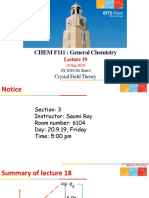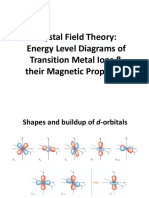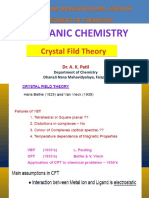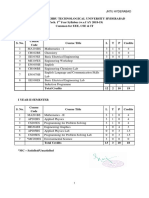Lecture 19 PDF
Uploaded by
Rachit ShahLecture 19 PDF
Uploaded by
Rachit ShahBITS Pilani
Pilani Campus
CHEM F111 : General Chemistry
Lecture 19
22 Feb 2019
AY 2018-19, Sem-II
CFT
1 BITS Pilani, Pilani Campus
Lecture 18- Summary
Topics discussed in last class
Isomerism
Shapes of d orbitals
Crystal field theory – Assumptions and general
descriptions
d-orbital splitting octahedral complexes
d-orbital splitting in tetrahedral complex
Spectrochemical series
2 BITS Pilani, Pilani Campus
Dependence of o
The magnitude (value) of o depends on
1. Nature/type of the ligand
2. Charge on the metal ion
3. Size of the metal ion; i.e., M belongs to I, II, or III row
3 BITS Pilani, Pilani Campus
Bonding in Coordination Complexes
Crystal Field Theory (CFT) – Approach of Ligands (Octahedral field)
Lobes are directed Lobes are directed in
towards ligands between ligands
greater electrostatic repulsion = higher potential energy
MORE Destabilized LESS Destabilized
4 BITS Pilani, Pilani Campus
Crystal Field Theory
Octahedral crystal field
_ _
d orbital energy levels dz2 dx2- y2
oct
E _ _ _
dxy dxz dyz
_____
Under ligand field ONLY
d-orbitals
isolated Metal ion and the nature of the ligand
metal ion determines oct
5 BITS Pilani, Pilani Campus
Spectrochemical series
Smallest
(weak) I- < Br- < S2- < SCN- < Cl- < NO3- < F- < OH- < EtOH
(ethanol) <C2O42- (oxalate) < H2O < EDTA < NCS- < CH3CN <
NH3 < en < bipy < phen < NO2- < PPh3 < CN- < CO (strong)
Largest
IMPORTANT POINTS
Based on experimental data
There is no apparent pattern
No charge or size correlation
Both the sigma and pi bonding nature along with electrostatic
attractions determine the crystal field splitting o
A pattern of increasing sigma donation can be as
Halide donors < O donors < N donors < C donors
6 BITS Pilani, Pilani Campus
Spectrochemical series
Within halide donors for o: I- < Br- < Cl- < F-: Explanation
Consider in terms of electrostatic
repulsions. F- is of small size and
hence more closer bonding and
more repulsion (higher o)
Explain the order PPh3 < CN- < CO
• o for CN- is almost double that of I- ; This can
not be explained by CFT. Covalent bonding of
and types of bonding is to be included
(pi) back bonding
•CO, phosphines are neutral ligands and still from metal t2g
produce the maximum splitting of d orbitals vacant ligand-orbital
which implies electrostatic-point charge model
is not sufficient
7 BITS Pilani, Pilani Campus
Nature of metal cation
(i) Different charges on the cation of the same metal:
Δo for [Fe(H2O)6]2+= 10,400 cm-1
Δo for [Fe(H2O)6]3+= 13,700 cm-1
For the same metal, the metal cation with a higher oxidation state
has a larger value of Δo than that with lower oxidation state.
Table: comparison of 0 for different M[(H2O)6]n+ complexes
Oxdn
M Ti V Cr Mn Fe Co Ni Cu
State
e’
+II d2 d3 d4 d5 d6 d7 d8 d9
config
o, cm-1 - 12600 13900 7800 10400 9300 8500 12600
e’
+III d1 d2 d3 d4 d5 d6 d7 d8
config
o, cm-1 20300 18900 17830 21000 13700 18600 - -
8 BITS Pilani, Pilani Campus
Nature of metal cation
(ii) Same d-electrons: Different charges on the cation of
different metal with same number of d-electron : Two different
cations with the same number of d-electrons but with different
charge (metals within a same period)
Δo for [V(H2O)6]2+= 12,600 cm-1
Δo for [Cr(H2O)6]3+= 17,830 cm-1
The cation with the higher charge will have bigger o
(iii) Same charge on the cation of different metal but different
d- electrons (metals within a same period): (Exceptional, trend
is not followed properly, many factors are responsible)
Δo for [Co(H2O)6]2+= 9300 cm-1
Δo for [Ni(H2O)6]2+= 8500 cm-1
9 BITS Pilani, Pilani Campus
Nature of metal cation
(iv) Size of the metal ion
Variation down any group
Δo for [Cr(NH3)6]3+= 24,800 cm-1
Δo for [Ru(NH3)6]3+= 34,000 cm-1
Δo for [Ir(NH3)6]3+= 41,000 cm-1
The o of metal cations generally increase by almost 30 %,
moving down the group
- Larger the d orbital size it is easier to split, larger o
- 5d orbitals split larger than 4d orbitals, which in turn may be
larger than 3d, and so on
10 BITS Pilani, Pilani Campus
Electronic configuration of
Octahedral (Oh) complexes
Expected orbital filling tendencies for electrons:
Occupy lowest energy vacant orbitals first
Occupy a set of equal energy orbitals one at a time (Hund’s
rule), which minimizes repulsions
d orbital occupancy depends on Δ and pairing energy, P
• If Δ > P (Δ is large; strong field ligand)
e-’s pair up in lower energy d-orbitals first
• If Δ < P (Δ is small; weak field ligand)
e-’s spread out among all d-orbitals before any pair up
P is a constant for each metal ion
11 BITS Pilani, Pilani Campus
d orbital occupancy
d1 d2
d4 d4
high spin, < P low spin, > P
Configuration with higher number of unpaired electrons is called
HIGH Spin or Spin-free, one with lowest number of unpaired spins is
called LOW-spin or spin-paired configuration
12 BITS Pilani, Pilani Campus
Tetrahedral complexes
_
_
_ t2
2/5 Δt
__
E __
_
3/5 Δt
__
e
• t2 orbitals are in higher energy as opposed to octahedral field.
• Since there is no centre of symmetry in tetrahedron the parity
subscript g is omitted.
• The total tetrahedral splitting is t
13 BITS Pilani, Pilani Campus
Tetrahedral complexes
In general t < o ,
• Since there are only 4 ligands compared to 6 in octahedron; this
gives 2/3 reduction from the octahedral crystal field splitting.
• d-orbitals do not coincide with the direction of M-L bonds; this
gives another 2/3 reduction in the interaction energy
So for the same ligand and same metal ion
t = (4/9)o (approximately)
Due to this low t values almost all the tetrahedral complexes are
High Spin (No pairing), there are a few exceptions though
14 BITS Pilani, Pilani Campus
Octahedral vs. tetrahedral
Octahedral
____ e
Tetrahedral g
____
t2 __ 0.6 ΔO
E 0.4 Δt __
__
_
Bari center -0.4 ΔO
-0.6 Δt
(considering same) ____
___
_ __ t2g
e
So for the same ligand and same metal ion
t = (4/9)o (approximately)
15 BITS Pilani, Pilani Campus
Example - d6 configuration
Weak Strong
eg t2g6eg0
eg
E o t2g4eg2 E o Octahedron
t2g t2g
t2 t2
e3t23
E e3t23 E
Tetrahedron
e e
16 BITS Pilani, Pilani Campus
Crystal Field Stabilization Energy
In the d1 system (t2g1eg0), one electron is 0.4 o below Bari Centre.
OR this electron is stabilized in an octahedral field w.r.t.
spherically symmetric field.
For an octahedral geometry:
Crystal Field Stabilization Energy = CFSE = (-0.4nt2g + 0.6neg) o ;
n = no. of electrons
[Ti(H2O)6]3+ : CFSE = -0.4 x 1 x o =-0.4x243 = -97 kJmol-1
eg
NOTE: This stability is w.r.t. Bari Centre
E t2g
17 BITS Pilani, Pilani Campus
CFSE for a d-electron configuration
eg
Similarly, V3+ = d2 = t2g2 So CFSE = - 0.8 o
E
t2g
Cr3+ = d3 = t2g3 CFSE = - 1.2 o eg
E
t2g
Due to Hund’s rule of maximum multiplicity the electrons are going to
different orbitals
18 BITS Pilani, Pilani Campus
CFSE of d4 configuration
Case I Case II
eg eg
E o E ’o
t2g t2g
Case I: involves pairing which requires energy input
Case II: electron is placed in high energy eg orbital
Note: In both the cases the fourth electron placement
raises the energy of the system
19 BITS Pilani, Pilani Campus
CFSE of d4 configuration
Case I Case II
eg eg
E o E ’o
t2g t2g
o>>’o
Case I Case II
P << o o’ << P
Low spin complex; high spin Complex;
Spin paired complex; spin free complex;
Strong ligands Weak ligands
20 BITS Pilani, Pilani Campus
CFSE for Octahedral complexes
Weak Field Ligand Strong Field Ligand
dn Configuration Unpaired CFSE Configuration Unpaired CFSE
electrons (in o) electrons (in o)
d1 t2g1 1 -0.4 t2g1 1 -0.4
d2 t2g2 2 -0.8 t2g2 2 -0.8
d3 t2g3 3 -1.2 t2g3 3 -1.2
d4 t2g3eg1 4 -0.6 t2g4 2 -1.6
d5 t2g3eg2 5 0.0 t2g5 1 -2.0
d6 t2g4eg2 4 -0.4 t2g6 0 -2.4
d7 t2g5eg2 3 -0.8 t2g6eg1 1 -1.8
d8 t2g6eg2 2 -1.2 t2g6eg2 2 -1.2
d9 t2g6eg3 1 -0.6 t2g6eg3 1 -0.6
d10 t2g6eg4 0 0.0 t2g6eg4 0 0.0
21 BITS Pilani, Pilani Campus
Tetrahedral complexes
Octahedral CFSE = (-0.4nt2g + 0.6 neg) o
Tetrahedral CFSE = (-0.6ne + 0.4 nt2) t
In octahedral cases, CFSE = 0 for d0, d5(weak) and d10 cases;
In Tetrahedral cases, CFSE =0 for d0, d5 and d10 cases irrespective
strong or weak field ligands
22 BITS Pilani, Pilani Campus
Uses of CFSE values
Stabilization of oxidation state
(i) [Co(H2O)6]3+ : 3d6 system, t2g4eg2, CFSE: -0.4 ΔO
(ii) [Co(H2O)6]2+ : 3d7 system, t2g5eg2, CFSE: -0.8 ΔO
(iii) [Co(NH3)6]3+ (CFSE: -2.4 ΔO) and [Co(NH3)6]2+ (CFSE: -1.8 ΔO)
23 BITS Pilani, Pilani Campus
Crystal Field Theory: lattice energy
CRYSTAL FIELD THEORY in explaining variation of Lattice Energy for
transition metal chlorides (1st row transition metals)
In these solids, the coordination
number of these metals is 6, hence
analogous to Oh complexes
Excess stabilization (-ve) energy
above the line can be from CFSE
d1 d2 d3 d4 d5 d6 d7 d8 d9 d10
Sc2+ Ti2+ V2+ Cr2+ Mn2+ Fe2+ Co2+ Ni2+ Cu2+ Zn2+
-0.4o -0.8o -1.2o -0.6o 0 -0.4o -0.8o -1.2o -0.6o 0
24 BITS Pilani, Pilani Campus
Crystal Field Theory: Hydration energy
CRYSTAL FIELD THEORY in explaining variation of Hydration Energy
of M2+ ions of first row transition elements
M2+(g) + H2O(excess) [M(H2O)6]2+ H= -ve
Zero CFSE cases are d0, d5
(weak) and d10 configurations
i.e. Ca2+, Mn2+, and Zn2+
All other ions have additional
stability which is CFSE –
Values obtained are in
agreement those from
spectroscopy
Analogy holds good for M3+
ions also 25 BITS Pilani, Pilani Campus
Crystal Field Theory: ionic radii
CRYSTAL FIELD THEORY in explaining variation of Ionic Radii of M2+
ions in Octahedral environment
Ca2+ Zn2+ nuclear charge increases
Additional electrons are going to the same shell
d electron shielding is poor
Therefore the size of the ions should decrease smoothly.
However, as seen in the following graph the radius change is not
smooth
26 BITS Pilani, Pilani Campus
Crystal Field Theory: ionic radii
Ionic radii of the dihalides of
the 1st transition series
Dark circles represents low spin
anions
t2g electrons : not oriented in the direction of metal-ligand bonds.
Less repulsion between the ligand and metal d electrons; closer
bonding and the ionic radius decreases.
V2+ d3 t2g3 ; nuclear charge is increased, but the additional
electron goes to t2g only; hence radius further decreases.
27 BITS Pilani, Pilani Campus
Explanation
Cr2+ d4 t2g3eg1 (weak field); The fourth electron is now placed in
an orbital directly in M-L bond; repulsion and ionic radius increases
Mn2+ d5 t2g3eg2 ; one more electron in eg; hence radius further
increases
Similarly for Fe2+, Co2+, Ni2+ (d6, d7, d8) the additional electrons go
to t2g orbitals and hence the radius decreases
For Cu2+ and Zn2+ the 9th and 10th d electrons go to eg orbital and the
radius increases
28 BITS Pilani, Pilani Campus
Discussed topics……
Factors affecting the magnitude of ΔO
Crystal field stabilization energy in Octahedral geometry
CFSE calculation of tetrahedral complexes
Uses of CFSE: stabilization of oxidation state, lattice energy,
hydration energy, and ionic radii
29 BITS Pilani, Pilani Campus
You might also like
- Chapter - 1 Crystal Field Theory in Octahedral Complexes NotesNo ratings yetChapter - 1 Crystal Field Theory in Octahedral Complexes Notes20 pages
- Advances in Inorganic Chemistry and Radiochemistry 1 (1959)100% (1)Advances in Inorganic Chemistry and Radiochemistry 1 (1959)463 pages
- Comparison of Octahedral and Tetrahedral Fields100% (1)Comparison of Octahedral and Tetrahedral Fields30 pages
- Approach of Six Anions To A Metal To Form A Complex Ion With Octahedral StructureNo ratings yetApproach of Six Anions To A Metal To Form A Complex Ion With Octahedral Structure9 pages
- Crystal Field Theory, CFSE Calculation-18-08-2023No ratings yetCrystal Field Theory, CFSE Calculation-18-08-202325 pages
- Coordination Chemistry: CHEM F111 Lecture 40No ratings yetCoordination Chemistry: CHEM F111 Lecture 4019 pages
- Crystal Field Theory (CFT) - Detailed Explanation With Examples & VideosNo ratings yetCrystal Field Theory (CFT) - Detailed Explanation With Examples & Videos2 pages
- Teoría Del Campo Cristalino, Espectroscopia ElectrónicaNo ratings yetTeoría Del Campo Cristalino, Espectroscopia Electrónica112 pages
- Crystal Field Theory In 20 Minutes_231217_224117No ratings yetCrystal Field Theory In 20 Minutes_231217_22411720 pages
- Chem Coordination Chemistry II Sem IV Hons 2nd PartNo ratings yetChem Coordination Chemistry II Sem IV Hons 2nd Part12 pages
- Coordination Chemistry Bonding in Transition-Metal ComplexesNo ratings yetCoordination Chemistry Bonding in Transition-Metal Complexes45 pages
- Lecture PPT METAL LIGAND BONDING in TransitionMetal ComplexesNo ratings yetLecture PPT METAL LIGAND BONDING in TransitionMetal Complexes81 pages
- CHE-501 Lecture 4 Crystal Field Theory by Dr. Charu C. PantNo ratings yetCHE-501 Lecture 4 Crystal Field Theory by Dr. Charu C. Pant43 pages
- Bonding in Coordination Compounds: Crystal Field Theory: Boundless ChemistryNo ratings yetBonding in Coordination Compounds: Crystal Field Theory: Boundless Chemistry20 pages
- Class-12 Chemistry Byjus Topicwise Notes CH 5 Crystal Field TheoryNo ratings yetClass-12 Chemistry Byjus Topicwise Notes CH 5 Crystal Field Theory55 pages
- Amorphous Semiconductors: Structural, Optical, and Electronic PropertiesFrom EverandAmorphous Semiconductors: Structural, Optical, and Electronic PropertiesNo ratings yet
- Endohedral Metallofullerenes: Fullerenes with Metal InsideFrom EverandEndohedral Metallofullerenes: Fullerenes with Metal InsideNo ratings yet
- FYUGP Syllabus: University of North BengalNo ratings yetFYUGP Syllabus: University of North Bengal20 pages
- Coordination Compounds 20 Years Pyq's With SolutionsNo ratings yetCoordination Compounds 20 Years Pyq's With Solutions7 pages
- Bonding in Complexes of D-Block Metal Ions - Crystal Field TheoryNo ratings yetBonding in Complexes of D-Block Metal Ions - Crystal Field Theory22 pages
- 12th TN Board Chemistry Second Midterm Most Important QuestionsNo ratings yet12th TN Board Chemistry Second Midterm Most Important Questions5 pages
- 32. TRANSITION METALS & COORDINATION CHEMISTRY_12-12-2024No ratings yet32. TRANSITION METALS & COORDINATION CHEMISTRY_12-12-202416 pages
- Karnataka II PUC Chemistry Model Paper 2025_1741840436380No ratings yetKarnataka II PUC Chemistry Model Paper 2025_17418404363806 pages
- Mini-Project Report On:-Crystal Field Theory: Isomers, Magnetic Properties and ColorNo ratings yetMini-Project Report On:-Crystal Field Theory: Isomers, Magnetic Properties and Color10 pages
- Chapter - 1 Crystal Field Theory in Octahedral Complexes NotesChapter - 1 Crystal Field Theory in Octahedral Complexes Notes
- Advances in Inorganic Chemistry and Radiochemistry 1 (1959)Advances in Inorganic Chemistry and Radiochemistry 1 (1959)
- Approach of Six Anions To A Metal To Form A Complex Ion With Octahedral StructureApproach of Six Anions To A Metal To Form A Complex Ion With Octahedral Structure
- Crystal Field Theory (CFT) - Detailed Explanation With Examples & VideosCrystal Field Theory (CFT) - Detailed Explanation With Examples & Videos
- Teoría Del Campo Cristalino, Espectroscopia ElectrónicaTeoría Del Campo Cristalino, Espectroscopia Electrónica
- Chem Coordination Chemistry II Sem IV Hons 2nd PartChem Coordination Chemistry II Sem IV Hons 2nd Part
- Coordination Chemistry Bonding in Transition-Metal ComplexesCoordination Chemistry Bonding in Transition-Metal Complexes
- Lecture PPT METAL LIGAND BONDING in TransitionMetal ComplexesLecture PPT METAL LIGAND BONDING in TransitionMetal Complexes
- CHE-501 Lecture 4 Crystal Field Theory by Dr. Charu C. PantCHE-501 Lecture 4 Crystal Field Theory by Dr. Charu C. Pant
- Bonding in Coordination Compounds: Crystal Field Theory: Boundless ChemistryBonding in Coordination Compounds: Crystal Field Theory: Boundless Chemistry
- Class-12 Chemistry Byjus Topicwise Notes CH 5 Crystal Field TheoryClass-12 Chemistry Byjus Topicwise Notes CH 5 Crystal Field Theory
- Amorphous Semiconductors: Structural, Optical, and Electronic PropertiesFrom EverandAmorphous Semiconductors: Structural, Optical, and Electronic Properties
- Endohedral Metallofullerenes: Fullerenes with Metal InsideFrom EverandEndohedral Metallofullerenes: Fullerenes with Metal Inside
- Coordination Compounds 20 Years Pyq's With SolutionsCoordination Compounds 20 Years Pyq's With Solutions
- Bonding in Complexes of D-Block Metal Ions - Crystal Field TheoryBonding in Complexes of D-Block Metal Ions - Crystal Field Theory
- 12th TN Board Chemistry Second Midterm Most Important Questions12th TN Board Chemistry Second Midterm Most Important Questions
- 32. TRANSITION METALS & COORDINATION CHEMISTRY_12-12-202432. TRANSITION METALS & COORDINATION CHEMISTRY_12-12-2024
- Karnataka II PUC Chemistry Model Paper 2025_1741840436380Karnataka II PUC Chemistry Model Paper 2025_1741840436380
- Mini-Project Report On:-Crystal Field Theory: Isomers, Magnetic Properties and ColorMini-Project Report On:-Crystal Field Theory: Isomers, Magnetic Properties and Color




































































































